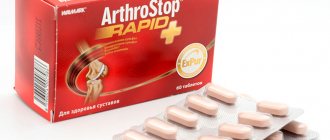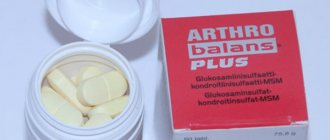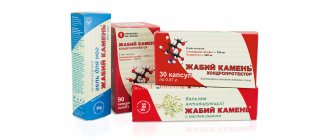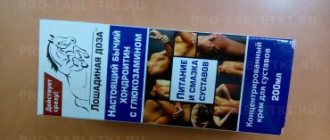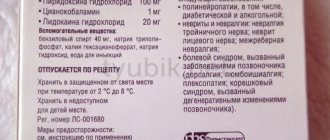Instructions for use CHONDROMED PLUS
Glucosamine hydrochloride
Suction
After oral administration of 14C-labeled glucosamine, it is rapidly and almost completely absorbed, and about 90% of the radioactive tracer is detected in the systemic circulation. The absolute bioavailability of glucosamine in humans after oral administration was 44%, taking into account the first pass effect. After daily oral administration of 1500 mg of glucosamine to healthy volunteers under fasting conditions, maximum plasma concentrations at steady state (Cmax,ss) averaged after 3 hours (Tmax) about 1602±426 ng/ml. At steady state, the AUC was 14,564±4138 ng×h/ml. It is unknown whether food intake has a significant effect on oral bioavailability. The pharmacokinetics of glucosamine are linear in the dose range of 750-1500 mg with deviation from linearity at a dose of 3000 mg due to lower bioavailability. There are no gender differences in the absorption and bioavailability of glucosamine. The pharmacokinetics of glucosamine were similar in healthy volunteers and patients with knee osteoarthritis.
Distribution
After oral absorption, glucosamine is distributed in various vascular compartments, incl. in synovial fluid, with an apparent volume of distribution 37 times higher than the total fluid volume in humans. Glucosamine does not bind to plasma proteins. Therefore, it is extremely unlikely that glucosamine is capable of drug interactions when taken together with other drugs that are highly bound to plasma proteins.
Metabolism
The metabolic profile of glucosamine has not been studied, since, being an endogenous substance, it is used as a “building material” for the biosynthesis of articular components of cartilage. Glucosamine is primarily metabolized by conversion to hexosamine, independent of the cytochrome system. It acts neither as an inhibitor nor as an inducer of human CYP450 isoenzymes, including CYP3A4, 1A2, 2E1, 2C9 and 2D6.00. There are no clinically significant interactions between glucosamine and other drugs that could occur through inhibition and/or induction of human CYP450 isoforms.
Removal
In humans, the half-life of glucosamine from plasma is 15 hours. After oral administration of 14C-labeled glucosamine, excretion in urine is 10±9%, in feces - 11.3±0.1% of the administered dose. The average excretion of unchanged glucosamine following oral administration in humans is approximately 1% of the administered dose, suggesting that the kidney and liver do not play a significant role in the elimination of glucosamine, its metabolites and/or its degradation products.
Pharmacokinetics in various categories of patients
Patients with impaired liver and kidney function.
Pharmacokinetic studies of glucosamine have not been conducted in patients with renal or hepatic impairment. These studies were considered inappropriate due to the insignificant contribution of the liver and kidneys in the processes of metabolism, degradation and excretion of glucosamine. Therefore, given the favorable safety profile and good tolerability of glucosamine, dosage adjustment of the drug is not required in patients with renal or hepatic impairment.
Children and teenagers.
The pharmacokinetics of glucosamine have not been studied in children and adolescents.
Elderly patients.
Pharmacokinetic studies have not been conducted in elderly patients, however, clinical trials of the efficacy and safety of glucosamine included mainly elderly patients. It has been shown that there is no need for dose adjustment in this category of patients.
Chondroitin sulfate
Pharmacokinetics have not been studied.
* Attention! Product packaging may differ from that shown in the photo.
Product description
Name:
Chondromed plus powder
INN:
Chondroitin sulfate; Glucosamine
Description:
White or white with a yellowish tint powder, odorless
ATX code: M01AX
Compound:
Active substance:
chondroitin sulfate sodium salt - 600.0 mg; glucosamine hydrochloride - 750.0 mg.
Excipients: anhydrous citric acid, fructose.
Release form:
Other nonsteroidal anti-inflammatory and antirheumatic drugs
pharmachologic effect
Pharmacodynamics
The effect of the drug Chondromed Plus is due to its constituent components. Chondroitin sulfate is a mucopolysaccharide and one of the components of cartilage. It has a high ability to bind water, thus ensuring the mechanical and elastic properties of cartilage. During degenerative processes in the joints, a decrease in the reserves of chondroitin sulfate in cartilage tissue, caused by specific lytic enzymes, is observed. As a result of the loss of the ability to bind water, cartilage degeneration and joint function worsen.
Chondroitin sulfate in vitro inhibits elastases, which destroy cartilage. The use of exogenous administration of chondroitin sulfate leads to the restoration of metabolic balance. Clinical effectiveness: clinical studies have shown that when using chondroitin sulfate, pain disappears or decreases and in most cases joint mobility improves.
Glucosamine - Administration of exogenous glucosamine provides nonspecific protection against chemical damage to cartilage. Another possible effect of glucosamine is the protection of damaged cartilage from metabolic destruction caused by nonsteroidal anti-inflammatory drugs (NSAIDs) and glucocorticosteroids (GCs), as well as its own moderate anti-inflammatory effect.
Pharmacokinetics
Chondroitin sulfate: after oral administration, the maximum concentration of the drug in plasma is achieved after 3-4 hours, in synovial fluid - after 4-5 hours. Bioavailability is about 13%. More than 70% of chondroitin sulfate is absorbed in the digestive tract. The drug absorbed in the gastrointestinal tract accumulates in the synovial fluid. Excreted from the body by the kidneys.
Glucosamine hydrochloride: rapidly absorbed in the small intestine. Bioavailability is 25-26% (due to the “first pass” effect through the liver). After tissue distribution, the highest concentrations are observed in the synovium, cartilage, liver and kidneys. Metabolized in the liver to form urea, water and carbon dioxide. It is excreted primarily in urine unchanged, and to a very small extent in feces. The half-life is about 70 hours.
Indications for use
Symptomatic treatment of degenerative-dystrophic diseases of the joints and spine: stage I-III osteoarthritis, osteochondrosis.
Directions for use and doses
The contents of the sachet should be completely dissolved in a glass of water and drunk immediately after preparation.
Chondromed plus is prescribed to adults and children over 12 years of age, 1 sachet 2 times a day (morning and evening) during the first month of use; in the following days, 1 sachet 1 time per day.
The minimum duration of treatment is 2 months. The optimal dosage regimen and duration of treatment is determined by the doctor.
Side effects
From the digestive system:
in some cases - flatulence, diarrhea, constipation, epigastric pain.
Allergic reactions:
in some cases - urticaria, itching.
Contraindications
- Individual intolerance (including a history of hypersensitivity) to the components of the drug;
- Pregnancy and lactation;
- Children under 12 years of age;
Pregnancy and lactation
It is not recommended to use the drug during pregnancy and lactation due to the lack of data confirming the safety of its use in women during this period.
Children
The drug is not used in children under 12 years of age.
Effect on driving
Chondromed Plus does not affect the ability to drive vehicles or engage in potentially hazardous activities that require increased attention.
Interaction with other drugs
With the simultaneous use of Chondromed plus with other drugs, it is possible to enhance the effect of indirect anticoagulants, antiplatelet agents, and fibrinolytics.
When used in combination, Chondromed Plus increases the absorption of tetracyclines and reduces the absorption of semisynthetic penicillins and chloramphenicol.
Compatible with non-steroidal anti-inflammatory drugs and glucocorticoids.
Precautionary measures
Caution should be used in patients with bleeding, as well as in patients with a tendency to bleeding. Caution should be exercised when prescribing to patients with severe renal and hepatic insufficiency.
Overdose
Symptoms
In rare cases, symptoms of overdose from the gastrointestinal tract, nausea, vomiting, diarrhea are possible; with prolonged use of excessively high doses, hemorrhagic rashes are possible
Treatment:
Symptomatic
Storage conditions:
In a place protected from moisture and light at a temperature not exceeding +250C
Keep out of the reach of children
Shelf life - 2 years
Package:
5.0 grams of powder in a bag made of a combined material
10 or 15 sachets in a cardboard box along with instructions for use
Manufacturer:
JLLC "Lekpharm"
Chondromed solution for intramuscular administration 200 mg/2 ml in ampoules No. 5x2
Name
Chondromed solution for intramuscular injection 200 mg/2 ml in amp. in pack No. 5x2
Description
Transparent, colorless or slightly yellowish liquid.
Main active ingredient
Chondroitin sulfate
Release form
Solution for intramuscular administration.
Dosage
200mg/2ml
Pharmacodynamics
The main active ingredients of the drug are sodium salts of chondroitin sulfate A and C (average molecular weight 11,000 daltons). Chondroitin sulfate is a high molecular weight mucopolysaccharide. It is the main component of proteoglycans, which together with collagen fibers make up the cartilage matrix. The drug has an anti-inflammatory and analgesic effect. Suppresses the activity of enzymes that cause degradation of articular cartilage: inhibits metalloproteinases, in particular leukocyte elastase. Reduces hyaluronidase activity. Partially blocks the release of free oxygen radicals; helps block chemotaxis and antigenic determinants. Anti-inflammatory and analgesic effects are achieved by reducing the release of inflammatory mediators and pain factors into the synovial fluid through synoviocytes and macrophages of the synovial membrane, as well as by suppressing the secretion of leukotriene B4 and prostaglandin E2. The use of the drug prevents compression of connective tissue, plays the role of lubrication of articular surfaces, normalizes the production of joint fluid, improves joint mobility, helps reduce pain intensity, and improves quality of life.
Pharmacokinetics
After intramuscular administration, the maximum concentration is reached within 1 hour, then the concentration of the drug slowly decreases over 2 days. Accumulates mainly in cartilage tissue (maximum concentration in articular cartilage reaches after 48 hours); the synovial membrane is not an obstacle to its penetration into the joint cavity. It is excreted from the body primarily by the kidneys within 24 hours.
Indications for use
Degenerative-dystrophic diseases of the joints and spine:
- primary arthrosis;
- osteoarthritis with predominantly damage to large joints;
- intervertebral osteochondrosis.
Directions for use and doses
The drug is administered intramuscularly, 1 ml every other day. If well tolerated, the dose is increased to 2 ml, starting with the fourth injection. The course of treatment is 25-35 injections. It is advisable to repeat the course of treatment 6 months after consulting a doctor.
Use during pregnancy and lactation
It is not recommended to use this drug during pregnancy and lactation due to the lack of data confirming the safety of its use in women during this period.
Use in children
It is not recommended to prescribe the drug to children due to the lack of data on the effectiveness and safety of use in children.
Impact on the ability to drive vehicles and operate machinery
Does not affect the ability to drive vehicles or potentially dangerous machinery.
Precautionary measures
In case of allergic reactions or hemorrhages, treatment should be discontinued. To achieve a stable clinical effect, at least 25 injections of the drug Chondromed are required. The effect lasts for many months after the end of the course of treatment. To prevent exacerbation, repeated courses of treatment are indicated.
Interaction with other drugs
When used in combination with non-steroidal anti-inflammatory drugs, Chondromed allows you to reduce their dose. The effect of indirect anticoagulants, antiplatelet agents, and fibrinolytics may be enhanced, which requires more frequent monitoring of blood coagulation parameters when used together.
Contraindications
Increased individual sensitivity to any of the components of the drug, tendency to bleeding, thrombophlebitis, pregnancy, lactation (breastfeeding should be stopped during treatment). Children under 15 years of age (efficacy and safety have not been established). With caution: in case of bleeding disorders, diabetes mellitus, in people with increased body weight, in patients receiving a low-salt diet, children under 18 years of age, in case of impaired renal function, in women planning pregnancy.
Compound
One ampoule contains: Active substance: chondroitin sulfate (in the form of sodium chondroitin sulfate) - 200 mg. Excipients: benzyl alcohol, 0.1 M sodium hydroxide solution or 0.1 M hydrochloric acid solution - up to pH 6.0 - 7.5, water for injection up to 2 ml.
Overdose
Symptoms: allergic reactions, hemorrhages at the injection site. Treatment: if necessary, symptomatic therapy is indicated.
Side effect
Allergic reactions: skin itching, erythema, urticaria, dermatitis. From the digestive system: rarely - nausea, vomiting, diarrhea. Other: bleeding at the injection site.
Storage conditions
In a place protected from light at a temperature not exceeding 25? C. Keep out of the reach of children.
Reviews
Zinaida, 53 years old
As I got older, I began to notice creaking in my knees, and sometimes there was even pain when straightening. The doctor recommended taking Chondromed. At first I took capsules, then switched to powder. After the prescribed course I feel a clear improvement. It became easier to move.
Andrey, 30 years old
Osteochondrosis “earned” from sedentary work. The pain was quite severe, so much so that sometimes it was difficult to turn my head. The doctor prescribed NSAIDs, but they had a short duration of action, and after a while everything started to hurt again. Friends recommended Chondromed. Of course, for the full effect it must be taken for a long time, but I noticed the first positive changes within a week.
Marina, 45 years old
Doctors diagnosed me with arthrosis of the hip joint. At first they gave injections with Aflutop. Expensive, painful and ineffective (for me anyway). I decided to try simpler chondroprotectors and chose Chondromed. I took it for a month. The powder really helped. The pain is gone. According to the recommendations, I want to drink for another six months after the break to consolidate the results.
Indications and contraindications
The instructions for use recommend using “Chondromed Plus” for patients with degenerative-dystrophic lesions of the joints and spine, such as osteochondrosis and arthrosis at any stage of development.
Patients with liver and kidney failure, as well as with a tendency to internal bleeding, should consult with their doctor so that he can objectively assess the possible risks and advisability of taking the drug.
Contraindications for use are:
- hypersensitivity to one or more components of the drug;
- allergic reactions to seafood (the source of glucosamine, as a product of chitin processing, is mollusk shells and crustacean shells);
- pregnancy and lactation;
- age up to 12 years.
Analogs
| A drug | Release form | Price, rub.) |
| "Glucosamine-chondroitin complex" | pills | 2380 |
| "Don" | powder for solution | 1340 |
| "Glucosamine Maximum" | pills | 750 |
| "Honda Evalar" | cream-gel | 380 |
| "Mukosat" | solution in ampoules for injection | 650 |
| "Nemulex" | granules for suspensions | 300 |
Chondroprotectors
Calcium Sandoz Forte effervescent tablets 500 mg 20 pcs.
The combination of calcium carbonate + calcium lactogluconate may reduce the absorption of estramustine, etidronate and possibly other bisphosphonates, phenytoin, quinolones, oral tetracycline antibiotics and fluoride preparations. The interval between taking effervescent calcium carbonate + calcium lactogluconate tablets and the above drugs should be at least 3 hours. Simultaneous administration of vitamin D and its derivatives increases calcium absorption. When prescribed in high doses along with vitamin D and its derivatives, calcium may reduce the effect of verapamil and possibly other calcium channel blockers. With the simultaneous use of effervescent calcium carbonate + calcium lactogluconate tablets and tetracycline drugs, the absorption of the latter may be impaired. For this reason, tetracycline preparations should be taken at least 2 hours before or 4-6 hours after ingesting calcium preparations. Thiazide diuretics reduce urinary calcium excretion, therefore, when used concomitantly with calcium carbonate + calcium lactogluconate effervescent tablets, regular monitoring of serum calcium concentrations should be carried out, as there is a risk of developing hypercalcemia. Systemic corticosteroids reduce calcium absorption. If they are used simultaneously, it may be necessary to increase the dose of effervescent calcium carbonate + calcium lactogluconate tablets. When ingesting effervescent calcium carbonate + calcium lactogluconate tablets in patients receiving cardiac glycosides, the toxicity of cardiac glycosides may increase due to the development of hypercalcemia. Such patients should regularly take an ECG and monitor the level of calcium in the blood serum. If a bisphosphonate or sodium fluoride is taken orally, these drugs should be taken at least 3 hours before taking calcium carbonate + calcium lactogluconate effervescent tablets, since absorption from the gastrointestinal tract (GIT) of the bisphosphonate or sodium fluoride may be reduced. Calcium absorption from the gastrointestinal tract may be reduced by concomitant intake of certain foods containing oxalic acid (eg, spinach, rhubarb) or phytic acid (in all grains) due to the formation of insoluble complexes with calcium ions. Patients should not take calcium carbonate + calcium lactogluconate effervescent tablets 2 hours before or after meals rich in oxalic or phytic acid.
